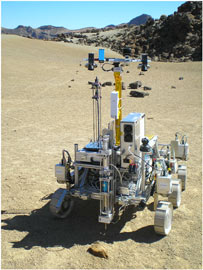Ultrasonic drill tools for planetary exploration

Drilling on the surface of extraterrestrial planets such as Mars is difficult.
The low gravity means that the rover on which the drill could be mounted will appear to have very little weight, which makes it difficult to press the drill firmly against the rock. The next generation of Mars landers will therefore require a new system for drilling into the surface soil, rock and ice.
Our approach
A Mars drill should have three main characteristics: it should be able to achieve penetration with a low drilling force, it should have low electrical power consumption, and it should have a simple deployment process. To achieve these aims, we use high-frequency ultrasonic vibrations to excite a hammering action in a drillbit rather than pressing the drillbit down from above as in a traditional household drill. This means that the applied forces are lower, less power is required, and the support architecture can be scaled back to simplify the system.
Why is this research important?
It is thought that in the past Mars was much warmer and wetter than it appears to be today. This means that there could be important evidence of flowing water, or even life, just below the surface. To learn about the planet and solar system’s past, future spacecraft will have to use drill tools such as the ultrasonic device to obtain access to these underground areas.

